Arts prof Isaac Julien highlighted
Above: A photographic artwork from Isaac Julien’s Playtime series, ECLIPSE (Playtime), 2013.
UC Santa Cruz recently collaborated with the Los Angeles County Museum of Art (LACMA) to present a daylong symposium on the works of influential British filmmaker and installation artist Isaac Julien.
A central figure in British visual culture, black British cultural studies,
and queer independent cinema for the last two decades, Julien recently joined the UC Santa Cruz faculty
as a distinguished professor of the arts.
The symposium took place in May in conjunction with the exhibition Isaac Julien: Playtime, his first major presentation in Los Angeles, which ran at LACMA from May 5 to August 11.
Held in the permanent collection at LACMA, Playtime (2014) is a critique of the influence of capital in the art world, starring James Franco, Maggie Cheung, Colin Salmon, and auctioneer Simon de Pury. Six vignettes demonstrate the different levels of how money has an effect on producing, dealing, and collecting contemporary art, as well as the lives affected by the system.
(For more on actor James Franco, see “Pipe dreams,” about alumnus Tom Franco’s art, page 6.)
Championing female role models in games and tech

UC Santa Cruz arts professor Robin Hunicke (far left) on the set of Project Runway.
— Photo courtesy of Alexandra Lo Re, NBCUniversal
Arts professor Robin Hunicke made a special appearance on Project Runway in April.
She served as a guest judge on the popular reality television show for an episode where the participants were tasked with designing their own powerful female video game characters.
Hunicke is director of art and design for the games and playable media B.A. program at UC Santa Cruz, as well as the acting director of the campus’s digital arts and new media M.F.A. program.
She is also cofounder and CEO of the independent game design company Funomena, which in late 2017 released her acclaimed PC and VR game, Luna.
“Last fall, a Project Runway producer asked if I would be interested in helping out with a show that focused on games, and in particular, the need for strong female role models in games, tech, and creative industries,” said Hunicke. “I have been a fan of this show for many years, and so I had to pinch myself. And then I said yes!”
Pipe dreams
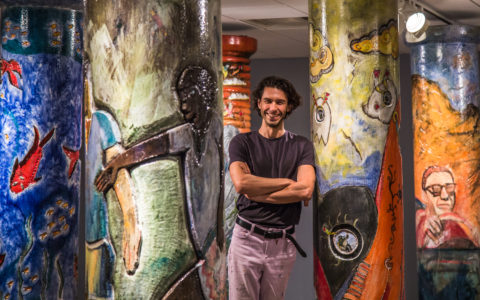
Tom Franco at the Arizona State University exhibit with his artistic pipes.
— Photo courtesy of the artist
Marija Nelson Bleier and Tom Franco watched as a crane lifted the colorful, 800-pound sculpture 30 feet into the air.
The piece, carved and painted by Franco from an eight-foot-tall clay sewer pipe, was part of an exhibit Bleier had curated in her job as visual arts coordinator for the town of Danville. There were to be three of these huge ceramic sculptures set outside the town’s 1,200-square-foot gallery space.
For both UC Santa Cruz alums, that moment of flying art was a tangible example of the importance of collaboration and of community.
“It was an awesome moment,” said Bleier (Cowell ‘99, art history). “I thought, ‘Look at all the people it takes to get this artwork in place.’”
“It really elevated what I was doing and what my group was doing,” said Franco (Porter ‘02, fine arts). “It was art to be seen.”
Franco—whose brothers James and David are well-known actors and his mother, Betsy, an acclaimed author—
is an Oakland actor, sculptor, and mixed-media artist, and the founder of the Firehouse Art Collective,
which provides space for artists in the Bay Area.
(For more on actor James Franco, see “Arts prof Isaac Julien highlighted,” page 5.)
Celebrating first feminist studies Ph.D.s
In June, Erin McElroy and Veronika Zablotsky became the first students to graduate from UC Santa Cruz with a Ph.D. in feminist studies.
The UC Santa Cruz Feminist Studies Department was founded in 1974 and is one of the oldest and largest programs focused on gender and sexuality studies in the country. The department accepted its inaugural grad cohort in 2013.
The Ph.D. program in feminist studies has two objectives: to train scholars and teachers, and to develop professional skills for careers in areas such as public policy and human rights research and advocacy.
Ethics Bowl looks way (WAY) into the future
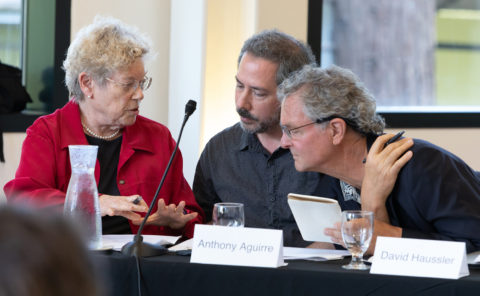
Professors Sandra Faber (astronomy and astrophysics), Anthony Aguirre (physics), and David Haussler (Genomics Institute) debate how much of our time and resources, if any, should be put into thinking about the far future.
— Photo by Kristin Jones Heitzler
What role should thinking about the far future—1,000 years ahead and beyond—play in research on campus?
That was the key question discussed in Ethics and the Far Future, the first UC Santa Cruz Faculty Ethics Bowl, which took place in May on campus.
Professors David Haussler (Genomics Institute), Sandra Faber (astronomy and astrophysics), and Anthony Aguirre (physics), faced off with Pranav Anand (linguistics), Sylvanna Falcón (Latin American and Latino studies), and Nico Orlandi (philosophy) to debate how much of our time and resources, if any, should be put into thinking about the far future.
But it wasn’t your ordinary run-of-the-mill debate. Ethics Bowl is very different from traditional debate formats. The teams are docked for using rhetoric, spin, aggression, and clever rationalization. Instead, each team is judged on the basis of active listening, flexibility, collaboration, and analytical rigor—essential ingredients for a meaningful discussion on difficult topics.
UCSC engineers to lead Center of Excellence

Professor Ricardo Sanfelice will lead a team of researchers participating in a new Center of Excellence for Assured Autonomy in Contested Environments.
— Photo by Carolyn Lagattuta
Ricardo Sanfelice, a professor of electrical and computer engineering in the Baskin School of Engineering, will lead a team of researchers at UC Santa Cruz participating in a new Center of Excellence for Assured Autonomy in Contested Environments led by the University of Florida.
Funded by the U.S. Air Force Office of Scientific Research (AFOSR), the center will focus on fundamental research to enable cyber-secure robotic systems with new capabilities.
The center, which also includes researchers at Duke University and the University of Texas at Austin, will collaborate with the Air Force Research Laboratory. AFOSR selected the team as the single winner of this prestigious Center of Excellence from among several elite groups competing across the nation. The sponsorship will cover an initial two-year period of $2 million, with optional extensions up to a total of six years and $6 million.
Sanfelice’s expertise is in the analysis and design of algorithms for cyber-physical systems, which depend on the seamless integration of computational algorithms and physical components, and hybrid dynamical systems, in which continuous and discrete variables interact.
Microscopic focus
For biologists, the golden age of microscopy is now. Powerful techniques developed in recent decades enable scientists to study living cells in unprecedented detail, and new techniques continue to push the limits of light microscopes.
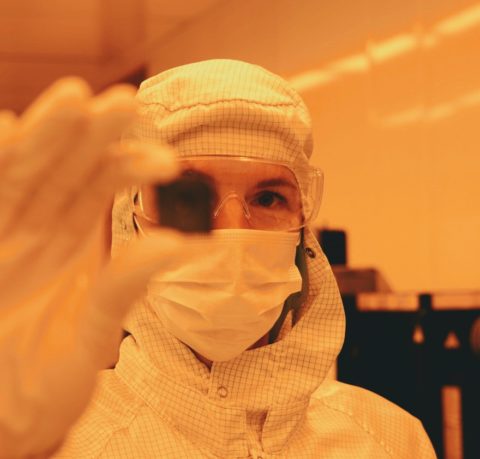
Assistant Professor Sara Abrahamsson at the nanofabrication facility where her team makes their custom-designed optics components.
— Photo by Gustav Pettersson
Sara Abrahamsson, an assistant professor of electrical and computer engineering at UC Santa Cruz, is at the forefront of innovations in optical microscopy. She invented a technique that enables three-dimensional imaging of living cells. More recently (in 2017), she showed that that technique can be combined with another one to provide “super-resolution” beyond the classical limits of light microscopes.
Now, Abrahamsson is working with UC Santa Cruz biologists to build and test the first multi-focus structured illumination microscope. She won a $700,000 major research instrumentation grant from the National Science Foundation to fund the project.
Abrahamsson’s lab has already built one multi-focus microscope and installed it in the UC Santa Cruz Life Sciences Microscopy Center.
Study opens new front in cancer fight
Unregulated cell division is a hallmark of cancer, and one of the key proteins involved in controlling cell division is called FoxM1. Abnormal activation of FoxM1 is a common feature of cancer cells and is correlated with poor prognosis, metastasis, and resistance to chemotherapy.
Now researchers at UC Santa Cruz have determined the structure of this protein—a kind of “master switch” for cell division—in its inactive or “off” conformation. This new understanding of the structure of FoxM1 could ultimately be used to design new drugs that stabilize the protein in its inactive state and thereby stop the uncontrolled proliferation of cancer cells.
“When a cell is going to divide, there are a bunch of proteins that need to be made, and FoxM1 controls all the genes for those proteins,” said Seth Rubin, professor of chemistry and biochemistry at UC Santa Cruz. “Because cancer cells are proliferating and dividing all the time, they need to activate FoxM1, so it has long been a target for drug development.”
Succulent savior

Stephen McCabe surveying Dudleya sites following the Springs Fire.
— Photo by Mark Elvin/USFWS
Stephen McCabe scrambled up the cliff in Ventura County, hoping his instincts would prove him right.
An experienced climber and a researcher with UC Santa Cruz’s Environmental Studies Department, McCabe was part of a U.S. Fish and Wildlife Service project to ensure the survival of the rare silvery-green succulent, Verity’s Dudleya, which had been nearly wiped out by the 2013 Springs Fire in Ventura County and then hit by alleged poachers a while later.

Many species of Dudleya are being endangered, not only by climate change but also by bands of poachers who have stolen thousands of these plants.
— Photo by Ashley McConnell/USFWS
Sure enough, McCabe, who is also emeritus director of research at the UC Santa Cruz Arboretum & Botanic Garden, found a subpopulation of Verity’s Dudleya on the cliff face, marking a small victory in the fight to preserve this federally protected plant.
Many species of Dudleya are being endangered, not only by climate change but also by poachers who have stolen thousands of the plants. A single mature Dudleya can cost up to $50 on the black market in China and South Korea.
McCabe is considered an expert on the Dudleya, which is the panda bear of plants—cute, charismatic, and rare—and also is at the forefront of efforts to save the succulent.
Leading the charge for change
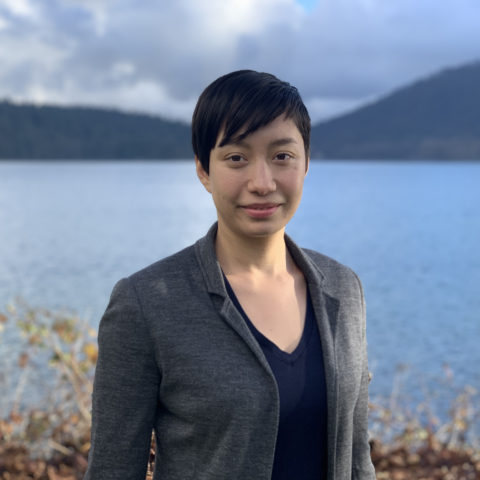
Alumna Amita Kuttner, who received her Ph.D. in astrophysics from the Physics Department in June and is a Green Party candidate for a seat in Canada’s House of Commons.
Amita Kuttner was away at boarding school in 2005 when the mudslide hit her parents’ home outside of Vancouver, Canada.
Tons of rocks, soil, and trees swept through her parents’ hillside house, killing Kuttner’s mother, Eliza, while she slept and tossing her father, Michael, into the maelstrom. He survived but suffered permanent brain injuries, according to Kuttner (College Nine ‘13, physics; M.A. ‘16, physics; Ph.D. ’19, astrophysics).
The slide came after several days of extreme rain, and while Kuttner said she can’t specifically blame the disaster on climate change, she’s seen the devastating effects of recent wildfires, hurricanes, and floods sparked by the Earth’s warming. She couldn’t just sit by, she said.
Kuttner received her Ph.D. in astrophysics from the Physics Department in June, but she’s also running as a Green Party candidate for a seat in Canada’s 338-member House of Commons in order to help make policy for the changes we’re facing.
“I love to do astrophysics,” she said, “but right now we have to save the planet so that we can do astrophysics.”
The election is October 21.
Homegrown expert
For the first time, the University of California has hired a Cooperative Extension specialist dedicated to organic agriculture.
Joji Muramoto, a longtime research associate with UC Santa Cruz, is coordinating a statewide program focused on the organic production of strawberries and vegetables. He started in May.

Joji Muramoto is the first Cooperative Extension specialist dedicated to organic agriculture.
— Photo by Carolyn Lagattuta
Muramoto is highly regarded for the depth of his knowledge of soil science and for his pioneering contributions to the organic production of strawberries—a high-value crop that is notoriously vulnerable to pests and soil-borne disease. He has a joint affiliation with UC’s Cooperative Extension (CE) and the Environmental Studies Department and the Center for Agroecology & Sustainable Food Systems (CASFS) at UC Santa Cruz.
CE specialists serve as liaisons between the university and the agricultural sector, building research programs that align with the needs of farmers and conducting collaborative on-farm studies that address problems growers are facing.
“I’m honored and humbled to have this position,” said Muramoto, who plans to focus on soil fertility and the organic management of soil-borne diseases.
Teaching the teachers
UC Santa Cruz received a $1.45 million grant from the National Science Foundation’s Robert Noyce Teacher Scholarship Program to recruit and prepare new math and science teachers in partnership with regional school districts and community colleges.
This is the third in a series of five-year NSF grants supporting the UC Santa Cruz Cal Teach program and Education Department in their efforts to increase the number and retention of new, highly qualified science and math teachers in high-need California public schools.
“The goal for this project is to strengthen the regional pipeline that supports students who are interested in math and science teaching careers,” said Cal Teach Director Gretchen Andreasen.
The Cal Teach program serves UC Santa Cruz undergraduates in science, mathematics, or engineering majors, as well as prospective transfer students from regional community colleges who are interested in teaching careers. The program offers internship placements in schools during the academic year, as well as summer teaching internships.
Bookshop launches Slug Shop
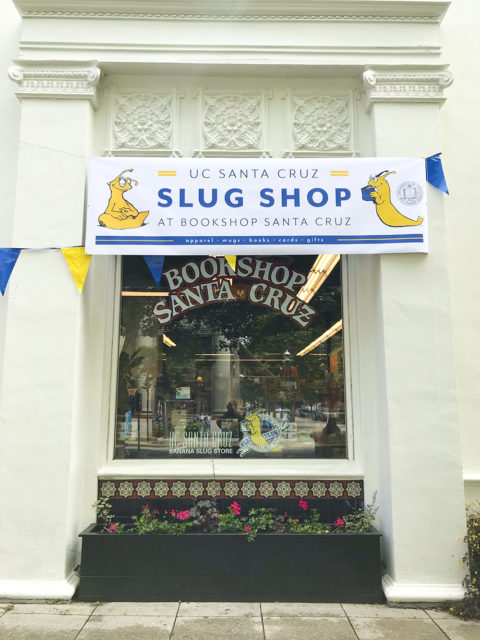
Bookshop Santa Cruz now hosts the UC Santa Cruz Slug Shop, carrying UC Santa Cruz–themed merchandise and serving as headquarters for UC Santa Cruz/Bookshop Santa Cruz partnerships.
— Photo by Suz Howells
Bookshop Santa Cruz recently debuted the brand-new UC Santa Cruz Slug Shop, a shop-within-a-shop at the bookstore that hosts a collection of UC Santa Cruz–themed clothing and other merchandise, and will also serve as headquarters for UC Santa Cruz/Bookshop Santa Cruz partnerships.
Some high-profile events are already in the works, including a reading by Pulitzer Prize–winning author Colson Whitehead on September 19 and a talk by bestselling writer Malcolm Gladwell on September 21 (see page 2).
Bookshop Santa Cruz owner Casey Coonerty-Protti said that it was only a matter of time before two of Santa Cruz’s best-known and most influential institutions joined forces. After all, the bookstore and university have had a longstanding cordial and synergistic relationship. Even their birthdays fall close together: UC Santa Cruz opened its doors to students in 1965, while Bookshop has been around since 1966.
“Bookshop is Santa Cruz’s living room, and it just made sense for UC Santa Cruz to be represented here,” Coonerty-Protti said. “And there is just limitless potential to cosponsor events.”
Alumni Excursion: Seeing sea change
They sailed the seas and watched the giants of the deep. They were treated to behind-the-scenes tours and firsthand looks at research. They hiked along coastal bluffs to catch glimpses of seals as big as cars.
It was all a part of a first for UC Santa Cruz Alumni Excursions, a set of curated events intended to expand knowledge on particular topics.
Sustainability-minded Banana Slugs returned to UC Santa Cruz during Alumni Weekend in April to attend the first excursion. The trip, called “The Effects of Climate Change on Marine Life,” offered a glimpse into how UC Santa Cruz researchers are contributing to the discussion of climate change and its effects on marine ecosystems. Over a span of three days, participants engaged in selected marine activities and academic talks on the topic of climate change.
For information about future Alumni Excursions, contact Sam Li at sakli@ucsc.edu or (831) 459-4631 or Nichole Silva at nsilva@ucsc.edu or (831) 459-3689.
If you are interested in other travel opportunities with UC Santa Cruz faculty, visit Inspired Expeditions, the university’s new travel program, at travel.ucsc.edu (and see the inside front cover of this issue for information on the next scheduled trip, going to London).
Interim leader comes with high praise

Lori Kletzer.
— Photo by Carolyn Lagattuta
Graduate Studies Dean Lori Kletzer is serving as interim campus provost and executive vice chancellor after the departure of former CPEVC Marlene Tromp, who left at the end of June to become president of Boise State University.
Kletzer has deep roots on campus, arriving in 1992 as an assistant professor of economics. She served as Economics Department chair, then vice chair and chair of the Santa Cruz Division of the Academic Senate.
In 2010 she become provost and dean of faculty at Colby College. She returned to UC Santa Cruz as Division of Graduate Studies dean last year, and served as interim Arts Division dean for a short period, earning rave reviews
She brings to the CPEVC role great experience as a provost, a high level of intellectual prowess, and a track record of collaboration.
Feeding the student body
Hunger on college campuses is a significant problem, with some estimates indicating that more than 40 percent of UC students face some degree of food insecurity. A new study suggests that enrolling students in CalFresh—the state’s food assistance program for low-income residents—not only addresses student hunger but also boosts the retention rate of participating undergraduates.
Researchers found that UC Santa Cruz first- and second-year undergraduates who enroll in CalFresh as part of Slug Support, the campus’s basic-needs program, were more likely to return to campus the following fall than their counterparts who didn’t enroll. The study was conducted by Rebecca London, an assistant professor of sociology, and Brandon Balzer Carr, a doctoral student in psychology.
The first-year retention rate for CalFresh enrollees hit 94 percent, only slightly higher than the overall retention rate of 92 percent—but substantially higher than the 87 percent rate of students who participate in Slug Support without enrolling in CalFresh. The pattern holds for second-year students, as well, according to London.
(For more on Slug Support and combating student hunger, see “Food for all,” opposite page.)
Alumni Weekend 2019: Slugs in the mist
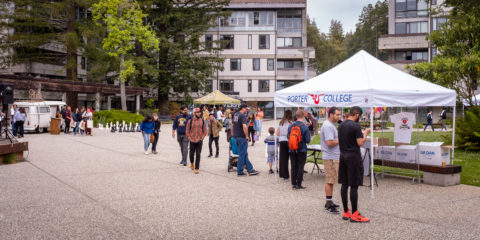
Alumni Weekend
— Photo by Kurtz Photographics
It’s well known that cool weather and fog bring out the banana slugs. That was certainly the case during UC Santa Cruz’s highly spirited—and often cloudy—Alumni Weekend in April, marked by myriad gatherings and offerings including reunions, lectures, conversation, jewelry-making, dancing, art tours, and “Slug Taxis’’ spiriting revelers from one event to the other.
It was impossible to do everything, considering there were 75 events, representing all 10 colleges. Activities appealed to all tastes, whether you were interested in the potential of life on other planets, or just wanted to hang out at the Porter College Makers Fair, with jewelry-making benches and a tie-dying tank for souvenir T-shirts.
More than a thousand people, including 560 alumni, converged on campus for a weekend of almost constant anniversaries and reunions. Seymour Marine Discovery Center marked its 40th birthday, the Smith Renaissance Society had its 20-year celebration, and UC Santa Cruz’s original graduating class marked its 50th anniversary with an emotional evening of reminiscing.
Find more UC Santa Cruz news at news.ucsc.edu. Have news delivered straight to your inbox! Subscribe to the UC Santa Cruz e-newsletter at news.ucsc.edu/newsletter.

